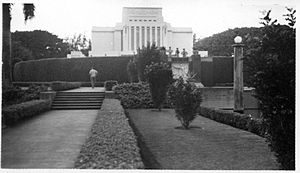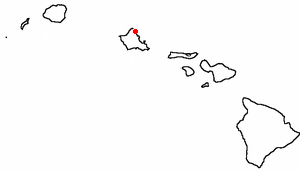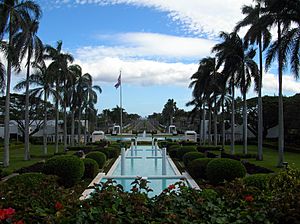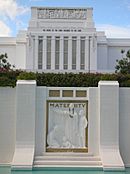Laie Hawaii Temple facts for kids
| Laie Hawaii Temple | |||||||||||||||||||||||||||||||||||||||||||||||
|---|---|---|---|---|---|---|---|---|---|---|---|---|---|---|---|---|---|---|---|---|---|---|---|---|---|---|---|---|---|---|---|---|---|---|---|---|---|---|---|---|---|---|---|---|---|---|---|
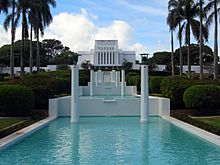 |
|||||||||||||||||||||||||||||||||||||||||||||||
| Number | 5 | ||||||||||||||||||||||||||||||||||||||||||||||
| Dedicated | Quick facts for kids November 27, 1919 byHeber J. Grant |
||||||||||||||||||||||||||||||||||||||||||||||
| Site | 11.4 acres (4.6 hectares) | ||||||||||||||||||||||||||||||||||||||||||||||
| Floor area | 42,100 sq ft (3,910 m2) | ||||||||||||||||||||||||||||||||||||||||||||||
| Preceded by | Salt Lake Temple | ||||||||||||||||||||||||||||||||||||||||||||||
| Followed by | Cardston Alberta Temple | ||||||||||||||||||||||||||||||||||||||||||||||
| Official website: https://www.churchofjesuschrist.org/temples/details/laie-hawaii-temple • News & images | |||||||||||||||||||||||||||||||||||||||||||||||
|
|||||||||||||||||||||||||||||||||||||||||||||||
The Laie Hawaii Temple is a special building for the Church of Jesus Christ of Latter-day Saints. It's located on the beautiful northeast shore of [[Oʻahu]], one of Hawaii's islands. The temple sits on a small hill, not far from the Pacific Ocean, in a town called [[Lāʻie]]. This town is about 35 miles (56 km) from Honolulu.
The Laie Hawaii Temple is very important to the town of Lāʻie. It's near Brigham Young University–Hawaii and the Polynesian Cultural Center. Many people visit the temple's Visitors' Center each year, with over 100,000 visitors annually.
This temple has been dedicated several times by different church leaders. Joseph F. Smith dedicated the land on June 1, 1915. Then, Heber J. Grant dedicated the finished building on November 27, 1919. Later, Spencer W. Kimball rededicated it on June 13, 1978, after it was made much bigger. Most recently, Thomas S. Monson rededicated the temple on November 21, 2010, after it had been updated and repaired.
The Laie Hawaii Temple was the first temple built by the church outside the main part of the United States. It's also the oldest temple still in use outside Utah. In fact, it's the fifth-oldest temple of the church that is still open today. It used to be called the Hawaiian Temple, but now it follows the standard naming for all church temples.
Contents
A Look Back: The Temple's Story
Early Days in Hawaii
The first ten missionaries from the Church of Jesus Christ of Latter-day Saints arrived in Hawaii in 1850. They sailed from San Francisco during the California Gold Rush. After a 20-day journey, they reached Honolulu Harbor on December 12, 1850. At that time, Hawaii was known as the "Sandwich Islands."
A week later, these missionaries received their assignments. They went to different islands like [[Kauaʻi]], Maui, and [[Hawaiʻi (island)|Hawaiʻi]]. Two stayed in Honolulu. These missionaries started what was called the Sandwich Islands Mission. The first church group in Hawaii began on Maui in 1851. Later, missionaries settled on Lānaʻi in 1854 and in Lāʻie on [[Oʻahu]] in 1865.
Building a Special Place in Lāʻie
In 1865, the church bought a large 6,000-acre (2,428-hectare) sugarcane farm for $14,000. This was meant to be a gathering place for church members in the area. Joseph F. Smith, who was a missionary in Hawaii, first suggested building a temple in Lāʻie in 1885. Later, George Q. Cannon, one of the first missionaries, visited Lāʻie in 1900. He was seen as a prophet for encouraging the idea of a new Hawaiian temple.
In 1915, Joseph F. Smith, who was then the sixth president of the church, announced that the first temple outside the main United States would be built in Lāʻie. There's a popular story about how the temple was built. Builders ran out of wood, which was hard to find on the islands. But then, a ship got stuck nearby and needed to unload some of its wood cargo. The temple builders helped the ship and were given the wood as a thank you. This wood was just enough to finish the temple!
When people from Hawaii and other Polynesian islands, who were living in Iosepa, Utah, heard about the new temple, many decided to move back to Hawaii. They had lived in Iosepa since 1889, but the closest temple there was 75 miles (120 km) away. Moving to Lāʻie meant they could be much closer to the new temple. By 1917, most of them had returned home, and Iosepa became a ghost town.
Church president Heber J. Grant dedicated the Hawaiian Temple on November 27, 1919. He believed the temple would attract many Polynesian church members. After the temple was finished, more Polynesians moved to Lāʻie to take part in temple ceremonies. Tourists also came to the area, and guidebooks even compared the Lāʻie temple to the famous Taj Mahal.
There's another interesting story about the Laie Hawaii Temple from 1941. Some people say that during the attack on Pearl Harbor, Japanese pilots tried to attack the temple but couldn't. The stories say they were stopped by mechanical problems or an unseen protective force. While these stories are popular, historians haven't found much proof to confirm them.
Modern Updates and Changes
In May 1976, the temple closed for two years for a big remodeling project. It grew from 10,500 square feet (975 square meters) to over 47,000 square feet (4,366 square meters). Church president Spencer W. Kimball rededicated the temple on June 13, 1978.
Another big project started in 2003, costing $5.5 million. It focused on making the area around the temple more beautiful. Old trees were replaced with new ones, and new lights and gardens were added. The Visitors' Center also got upgrades with interactive kiosks and new displays. Now, there's a model of the temple that lets visitors see inside, since only church members with a special pass can enter the actual temple.
In December 2008, the Laie Hawaii Temple closed again for more updates. This time, it was for structural and earthquake safety improvements. The rooms inside were also restored to look like they did originally. The temple was rededicated on November 21, 2010, by Thomas S. Monson.
In 2020, like all other temples, the Laie Hawaii Temple closed temporarily because of the coronavirus pandemic.
Temple Design and Art
Church president Joseph F. Smith wanted the Laie Hawaii Temple to look similar to Solomon's Temple from the biblical canon. The temple's design is often compared to the Cardston Alberta Temple. Young architects Hyrum Pope and Harold W. Burton designed both. Their work was inspired by the "Prairie style" of architecture, made popular by Frank Lloyd Wright. The temples also have designs that remind people of ancient Mesoamerican buildings.
The temple is built on an 11-acre (4.5-hectare) site that used to be part of a sugarcane farm. Construction began in February 1916. The builders used local materials like crushed lava rock and strong concrete. The temple's bright white look was created using special stone-cutting methods. From above, the temple looks like a cross. It is 50 feet (15 meters) tall, 102 feet (31 meters) from east to west, and 78 feet (24 meters) from north to south.
The outside of the temple has four large friezes, which are like carved pictures on the walls. These were designed by American sculptor J. Leo Fairbanks and his brother Avard Fairbanks. These carvings show stories about God's dealings with people. The north frieze tells stories from the Book of Mormon. The west frieze shows stories from the Old Testament. The south frieze depicts the New Testament and a time called the Apostasy. The east frieze shows the church being restored through Joseph Smith.
On the temple grounds, there are also statues made by the Fairbanks brothers. One shows Joseph being blessed by his father. Another shows the Prophet Lehi from the Second Book of Nephi in the Book of Mormon.
As visitors walk towards the temple, they pass several reflecting pools. In front of the highest pool is a special "Maternity Fountain." This carving, also by the Fairbanks brothers, honors Hawaiian mothers. It shows a Hawaiian mother holding a giant clam shell and pouring water over her children. This symbolizes how mothers pour their love and care into their children.
The temple grounds are filled with beautiful tropical gardens. You can see plants like hibiscus, Brazilian plume, birds of paradise, lantana, red ginger, bougainvillea, plumeria, and Ixora. At the bottom of the temple grounds, a fountain separates a Family History Center and a Visitors' Center. Inside the Visitors' Center entrance, there's a ten-foot (3-meter) tall statue of Bertel Thorvaldsen's Christus.
The Laie Hawaii Temple is 47,224 square feet (4,387 square meters) in size. It has three special rooms for ceremonies and six rooms for sealing families together. Many of the beautiful paintings inside the temple were designed by artist LeConte Stewart.
Who Can Enter the Temple?
The Laie Hawaii Temple is not like a regular church building where Sunday services are held. To enter the temple, church members need a special pass called a "temple recommend" from their local church leader. This pass allows them to participate in sacred ceremonies like endowments, baptism for the dead, and marriage.
Because of these rules, people without an active recommend cannot go inside the temple itself. However, everyone is welcome to tour the beautiful grounds outside and visit the Visitors' Center.
Temple Leaders
Some of the important leaders who have served as temple presidents include Edward L. Clissold (who served several times), D. Arthur Haycock, and J. Richard Clarke.
See also
 In Spanish: Templo de Laie para niños
In Spanish: Templo de Laie para niños
- Comparison of temples of The Church of Jesus Christ of Latter-day Saints
- Kona Hawaii Temple
- List of temples of The Church of Jesus Christ of Latter-day Saints
- List of temples of The Church of Jesus Christ of Latter-day Saints by geographic region
- The Church of Jesus Christ of Latter-day Saints in Hawaii


